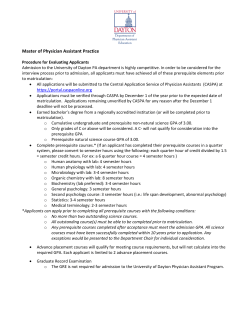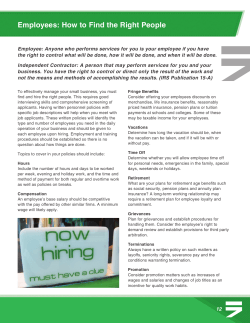
THE MEDICAL SCHOOL APPLICATION PROCESS FROM A-Z
THE MEDICAL SCHOOL APPLICATION PROCESS FROM A-Z David Verrier, Director, Office of Pre-Professional Programs and Advising, Johns Hopkins University Liza Thompson, Director, Post-Baccalaureate Premedical Program, Johns Hopkins University A TO Z… Applying to medical school is a long, arduous, challenging, and expensive undertaking. This presentation will focus on understanding the process of self assessment, applying to medical school, the preparation necessary, and executing the details. SOME FACTS ABOUT MEDICAL SCHOOL ADMISSIONS – ENTRY YEAR 2011 Allopathic Medicine 130+ medical schools 42,404 - applicants 18,527- accepted applicants 52% male applicants; 48% female applicants 24 – average age of beginning med students 3.53 – average cum GPA of applicants 3.68 – average cum GPA of accept students 3.43 – math/science GPA of applicants 3.62 – math/science GPA of accept students 26.4 O– average MCAT of applicants 29.3 P – average MCAT of accept students SOME FACTS ABOUT MEDICAL SCHOOL ADMISSIONS – APPLICATION YEAR 2011 Osteopathic Medicine 26 medical schools + three branch campuses 14,0877 – applicants 5,1577 – available seats 2.73 applicants per seat 53% male applicants; 47% female applicants 20% are in the age range 26-30 3.42 – average cum GPA of accepted applicants 3.32 – math/science GPA of accepted applicants 26 – average MCAT of accepted applicants WHICH PERSONAL COMPETENCIES ARE IMPORTANT TO SUCCESS IN MEDICAL EDUCATION AND PHYSICIAN PRACTICE? • Integrity and ethics • Reliability and dependability • Service orientation • Social, interpersonal, and teamwork skills • Desire to learn • Resilience and adaptability AAMC Innovation Lab, 2011 SELF-ASSESSMENT Volunteer/community experience Medically-related experience: clinical and/or research Grades and test scores: competitive cumulative and BCPM GPA competitive MCAT scores Strong references Solid Personal Statement: “Why do I want to become a physician?” Are you realistic? Are your “ducks in a row”? MEDICAL SCHOOL APPLICATION SERVICES AMCAS—for allopathic schools https://www.aamc.org/students/applying/amcas/ AACOMAS—for osteopathic schools https://aacomas.aacom.org/ The Texas Medical & Dental School Application Service (TMDSAS) http://www.utsystem.edu/tmdsas/ MEDICAL SCHOOL APPLICATION TIMELINE May June July Aug. Sept. Oct. Nov. Dec. Jan. Feb. March April May June July AMCAS/AADSAS/AACOMAS Medical School Interviews Acceptances Acceptances off of Waitlists June, 2012 Starting July 2012 First Date to submit Complete AMCAS Secondary AADSAS, Apps AACOMAS Mid-Sept., October 15, 2012 2012 Med./ Dental School interviews begin First acceptances sent out by medical schools with rolling admissions; AMCAS deadline for many schools Sept-Dec 2012 Continue work on Secondary Apps March, 2013 May 15, 2013 March – Aug, 2013 Last Date to Interviews Offers from end at most Hold Med/Dent medical Multiple Acceptances School schools Waitlists MEDICAL SCHOOL APPLICATION TIMELINE 2 o Early May – AMCAS and AACOMAS go online o Early June 2012– First date that you can submit your AMCAS or AACOMAS application. o You will begin receiving secondary applications shortly after you submit your AMCAS. Try to return these within a few weeks. This will increase your chances of getting an early interview slot. o Interviews at most medical schools begin in mid-September and often continue through the following winter and early spring. MEDICAL SCHOOL APPLICATION TIMELINE 3 o While some medical schools will accept students on a rolling basis and notify them as early as mid-October, others wait to notify all of their candidates in March/April. o Since most schools operate on a rolling basis, it is in your best interest to submit an application well before the deadlines. Aim to submit your application in June or July. o May 15, 2012 is the last day that you can hold multiple acceptances to medical schools; however, you should withdraw your applications as soon as you know you are no longer interested in a particular school. LETTERS OF RECOMMENDATION LETTERS OF RECOMMENDATION Whom should I ask? (choose recommenders carefully) How do I ask for a recommendation? What materials do I give to the recommender? Resume, personal statement, transcripts, publications (if any). What about waiving my right to see a letter? Medical schools prefer applicants to waive their right to see letters; this gives the letters more weight. How many are enough recommendations? How are my recommendations submitted? Don’t forget thank you notes! SENDING LETTERS OF RECOMMENDATION AMCAS -- Most medical schools receive letters through AMCAS. Evaluators submit letters electronically directly to the AMCAS Letter Service. AACOMAS -- Letters of Recommendation sent directly to colleges following the processes outlined by each college. Undergraduate Pre-Health Office--You also may use your undergraduate institution’s Pre-Health or Career Services Office. Contact the pre-health advisor to inquire about services for alumni. DECIDING WHERE TO APPLY – SLIDE 1 Location! How many? State residency Balance across selectivity (reaches, realistics, safeties) Cost—see next slide Mission and curriculum—see next slide Size and composition of student body Research vs. clinical emphasis; Special programs Prestige (all US medical schools have “prestige”) KEY RESOURCES: Allopathic: Medical School Admissions Requirements (MSAR) Osteopathic: College Information Booklet (CIB) DECIDING WHERE TO APPLY – SLIDE 2 Cost: Tuition (including in-state vs. out-of-state) Living Expenses (cost of living) Financial Aid Resources*: need-based or a limited number of merit scholarships Curriculum: Traditional – Courses Organized by Single Departments Progressive – Integrated Courses Involving Two or More Departments: Example – Organ Systems approach to teaching basic science Format – Lecture or Small Group (Case-Based, Problem Based, Discussion Groups) Clinical Exposure – 3rd and 4th Years of Medical School or Earlier; most schools now offer clinical exposure in the first year * For further information contact the financial aid offices at individual medical schools and access their websites. WHAT HAPPENS AFTER YOU APPLY? – SLIDE 1 In the Admissions Office - File created for application and credentials Huge backlog, do not expect a quick notification about decisions Some Schools Conduct Initial Review - Screening of MCAT scores and grades before sending “secondary” applications for students above the threshold; rejection those below the threshold Other Schools Send a Secondary to All - May include guidelines to help students determine if they are competitive WHAT HAPPENS AFTER YOU APPLY? – SLIDE 2 • Complete and return supplementary applications as soon as possible; aim for a two-week turnaround time. Some schools will have deadlines— read the secondaries carefully! • Be sure all other required credentials, such as letters of recommendation, are sent to AMCAS or the medical schools, as specified. • Possible Notification - receipt of application, what is needed, completion of application. Ultimately, you are responsible for all that is needed to complete the application. SCREENING After all items are received, one or more screeners fully review each application. Some schools may use a screening formula. Screening factors: Grades and MCAT Scores Most important factors during initial screening Letters of Recommendation Personal Essay The Quality (vs. Quantity) of Activities The Interview – has the greatest degree of weight at most schools THE MEDICAL SCHOOL INTERVIEW – SLIDE 1 • The interview invitation: A BIG first hurdle! Your chances of admission greatly increase, confidence builder. • Promptly schedule/confirm interview date; request change only if absolutely necessary. • Interview is used for both assessment and recruitment. • An opportunity to learn about the school’s curriculum, resources, and environment. • Be courteous to everyone! You are being assessed throughout the interview process. THE MEDICAL SCHOOL INTERVIEW – SLIDE 2 • If invited to stay overnight – a good way to learn about the school, get insight about student life. • Interview day: usually a tour and lunch with students and/or faculty, and an information session about financial aid. • Meet other applicants as colleagues not competitors. • One or more faculty interviews, possibly a student interview. • A few schools have a “Multiple Mini Interview” format. • Go to the interview prepared to ask questions and learn more about the school; questions also show you have done your homework. HOW APPLICANTS ARE ASSESSED AT THE STAGE OF THE INTERVIEW AND BEYOND • Social and communication skills • Clarity and flexibility of thinking • Evidence of motivation for a career in medicine • “Isms”: professionalism, humanism, altruism • Probe Depth of Activities (e.g. research, volunteerism, other areas that show talent) • Are you a good “fit” for the school? APPLICANT RIGHTS AND RESPONSIBILITIES • May 15 - deadline to make a final decision and reduce multiple acceptances to just one. Keep schools informed of your plans. • Immediately withdraw applications, interviews, and acceptances from all schools you do not plan to attend. • Be considerate to medical schools and other applicants, who may be desperately waiting for an acceptance. AAMC Recommendations for Medical School and MD-PhD Applicants AAMC Recommendations for Medical School and MD-PhD Admission Officers https://www.aamc.org/students/applying/recommendations/ KEY RESOURCES Medical School Admission Requirements https://www.aamc.org/students/applying/requirements/msar/ The Costs of Applying http://www.aamc.org/programs/first/facts/applyingcost.pdf Generic FAQ for MD/PhD Applicants (University of Penn) http://www.med.upenn.edu/mstp/applicantfaq.pdf AMCAS - The American Medical College Application Service http://www.aamc.org/students/amcas/ AMCAS instruction booklet (full version) http://www.aamc.org/students/amcas/amcas2009instruction manual.pdf
© Copyright 2025





















